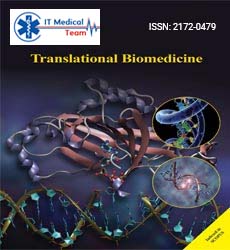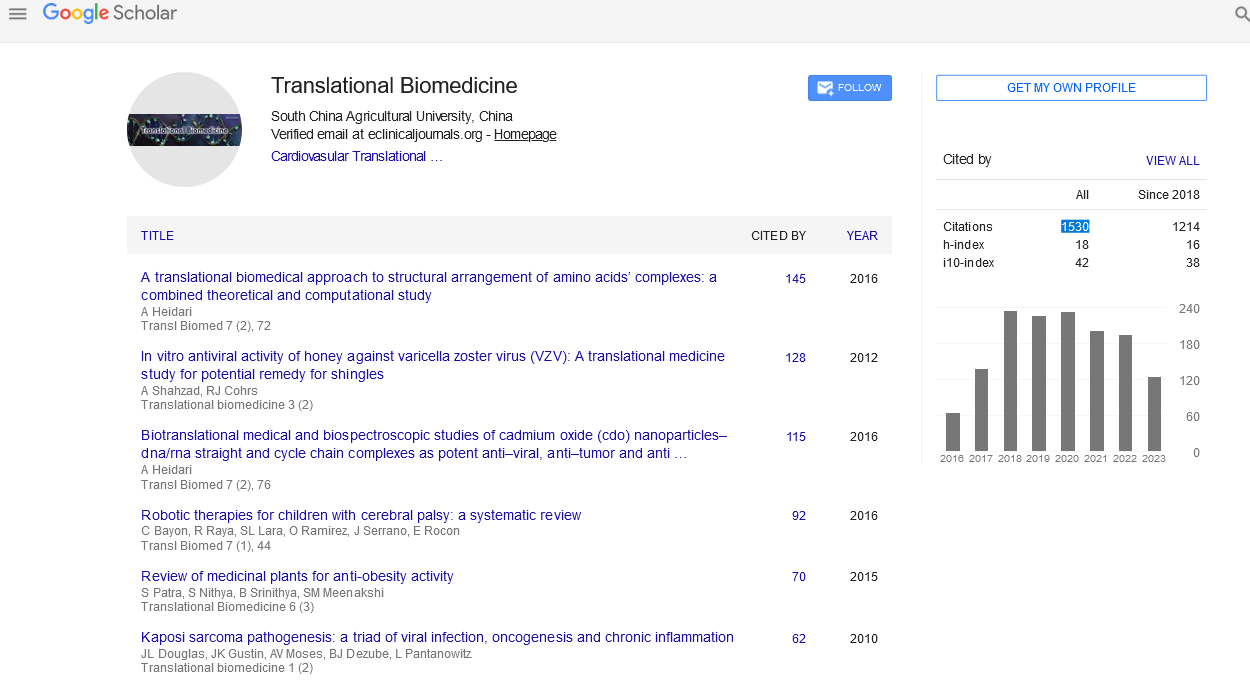Case Report - (2023) Volume 14, Issue 4
Revolutionizing Disease Detection: The Power of Molecular Diagnostics
Harry Nikolas*
Department of Molecular Diagnostics, Australia
*Correspondence:
Harry Nikolas, Department of Molecular Diagnostics,
Australia,
Email:
Received: 01-Jul-2023, Manuscript No. iptb-23-13864;
Editor assigned: 05-Jul-2023, Pre QC No. iptb-23-13864(PQ);
Reviewed: 20-Jul-2023, QC No. iptb-23-13864;
Revised: 24-Jul-2023, Manuscript No. iptb-23-13864(R);
Published:
31-Jul-2023
Abstract
Molecular diagnostics has emerged as a transformative approach in healthcare, revolutionizing disease detection and management. By analyzing genetic materials such as DNA and RNA, this field allows for precise identification of genetic variations, mutations, and markers associated with various diseases. The applications of molecular diagnostics span across infectious diseases, cancer, genetic disorders, and pharmacogenomics. Techniques such as polymerase chain reaction (PCR), nucleic acid sequencing, and advanced technologies like CRISPRCas9 gene editing and single-cell analysis have expanded the scope of molecular diagnostics. The integration of molecular diagnostics with artificial intelligence and bioinformatics further enhances its potential. However, challenges regarding cost-effectiveness, standardization, and accessibility need to be addressed. Despite these challenges, molecular diagnostics holds immense promise in improving patient outcomes, enabling targeted therapies, and ushering in an era of precision medicine.
INTRODUCTION
Disease detection is a critical component of modern
healthcare, guiding diagnosis, treatment decisions, and
patient outcomes [1]. Traditionally, diagnostic methods
relied on physical examination, laboratory tests, and
imaging techniques. While these approaches have been
valuable, they often have limitations in terms of accuracy,
speed, and the ability to provide personalized information
[2]. However, in recent years, a ground-breaking field
known as molecular diagnostics has emerged, transforming
the landscape of disease detection and revolutionizing
patient care. Molecular diagnostics involves the analysis
of genetic materials, such as DNA and RNA, to identify
specific genetic variations, mutations, or markers associated
with various diseases [3]. By delving into the intricate
molecular mechanisms underlying diseases, this approach
provides a deeper understanding of their root causes and
offers unparalleled precision in diagnosis and treatment.
The power of molecular diagnostics lies in its ability
to unravel the genetic blueprints of diseases, enabling
clinicians to make precise and informed decisions [4]. This
article explores the principles, applications, and future
prospects of molecular diagnostics, shedding light on how
it is reshaping disease detection and transforming the way
we approach healthcare. By harnessing the knowledge of
molecular biology and genetics, molecular diagnostics
opens up new possibilities for personalized medicine and
improved patient outcomes. In the following sections, we
will delve into the applications of molecular diagnostics
in various disease domains, including infectious diseases,
cancer, genetic disorders, and pharmacogenomics [5]. We
will explore the techniques and technologies employed
in molecular diagnostics, such as polymerase chain
reaction (PCR), nucleic acid sequencing, and cuttingedge
advancements like CRISPR-Cas9 gene editing
and single-cell analysis. Furthermore, we will discuss
the integration of molecular diagnostics with artificial
intelligence and bioinformatics, highlighting how these
collaborations enhance data analysis and interpretation.
While molecular diagnostics holds immense promise,
it is not without challenges [6]. We will also address the
issues of cost-effectiveness, standardization of protocols,
and accessibility to advanced technologies that need to be
overcome for widespread implementation. Additionally,
regulatory frameworks must adapt to keep pace with the
rapid advancements in the field to ensure the safe and
ethical use of molecular diagnostics. By unlocking the
secrets of our genetic makeup, molecular diagnostics has
the potential to transform healthcare as we know it. With its ability to provide faster, more accurate and personalized
diagnostic information, it empowers clinicians to make
informed decisions, select targeted therapies, and improve
patient outcomes [7]. The future of molecular diagnostics
looks promising, and its continued advancements will
undoubtedly shape the landscape of disease detection and
usher in an era of precision medicine.
Understanding molecular diagnostics
Molecular diagnostics involves the detection and analysis
of genetic materials, such as DNA and RNA, to identify
specific genetic variations, mutations, or markers associated
with various diseases [8]. It harnesses the knowledge of
molecular biology and genetics to uncover the underlying
causes of diseases at a molecular level. This approach enables
clinicians to make precise diagnoses and tailor treatment
plans based on an individual's genetic makeup.
Applications of molecular diagnostics
Infectious disease diagnosis: Molecular diagnostics has
revolutionized the detection and management of infectious
diseases [9]. Techniques such as polymerase chain reaction
(PCR) and nucleic acid sequencing allow for the rapid and
sensitive identification of pathogens like bacteria, viruses,
and parasites. This not only enables early diagnosis but also
aids in monitoring treatment response and tracking the
spread of infectious diseases.
Cancer diagnosis and treatment
Molecular diagnostics has significantly advanced our
understanding of cancer. It helps identify specific genetic
alterations associated with different types of cancers,
allowing for precise diagnosis and prognosis. Techniques
like fluorescence in situ hybridization (FISH) and nextgeneration
sequencing (NGS) assist in identifying
mutations, gene fusions, and chromosomal rearrangements,
guiding targeted therapies and personalized treatment
plans.
Genetic disorders
Molecular diagnostics plays a crucial role in identifying
genetic disorders, both inherited and sporadic. It allows for the detection of disease-causing mutations, gene
deletions, or duplications, aiding in genetic counseling,
prenatal testing, and preimplantation genetic diagnosis.
Early detection of genetic disorders can improve patient
outcomes through timely interventions and personalized
management strategies.
Pharmacogenomics
Molecular diagnostics is transforming the field of
pharmacogenomics, which focuses on how an individual's
genetic makeup influences their response to drugs. By
analyzing specific genetic variations, clinicians can predict
a patient's likelihood of adverse drug reactions or nonresponsiveness
to certain medications. This information
guides the selection of appropriate drugs and dosage
adjustments, optimizing therapeutic outcomes.
Future prospects and challenges
The future of molecular diagnostics looks promising,
with on-going advancements in technology and research.
New techniques like CRISPR-Cas9 gene editing,
digital PCR, and single-cell analysis are expanding
the scope of molecular diagnostics and improving its
sensitivity and specificity. Additionally, the integration
of molecular diagnostics with other fields like artificial
intelligence and bioinformatics promises enhanced data
analysis and interpretation. However, challenges remain.
Cost-effectiveness, standardization of protocols, and
accessibility to advanced technologies are areas that need
attention. Ensuring regulatory frameworks keep pace with
technological advancements is crucial to ensure the safe
and ethical implementation of molecular diagnostics.
CONCLUSION
Molecular diagnostics has revolutionized disease detection
by providing faster, more accurate, and personalized
diagnostic information. From infectious diseases to cancer
and genetic disorders, this powerful tool has transformed
the way we understand and manage diseases. As technology
continues to evolve, molecular diagnostics holds immense
potential for improving patient outcomes, enabling targeted
therapies, and ushering in an era of precision medicine.
REFERENCES
- Zhao Y, Wang H. Tissue-engineered stents for cardiovascular diseases: emerging research and applications. Expert Rev Med Devices. 2019; 16(11): 765-773.
Google Scholar
- Kim HK, Kim KY, Kim TK, et al. Biodegradable metals for cardiovascular stents: from clinical concerns to recent Zn-alloys. J Mater Chem B. 2019; 7(3): 5973-5982.
Google Scholar
- Giacoppo D, Gargiulo G, Capodanno D. Contemporary Coronary Stents A Review. JACC Cardiovasc Interv.2020; 13(9): 135-148.
Indexed at, Google Scholar, Crossref
- Kastrati A, Mehilli J, Pache J, et al. Analysis of 14 trials comparing sirolimus-eluting stents with bare-metal stents. N Engl J Med. 2007; 356(111): 1030-1039.
Indexed at, Google Scholar, Crossref
- Yoon YH, Shin SW, Yang WJ, et al. Biodegradable magnesium stents for coronary artery stenosis. Clin Exp Pharmacol Physiol. 2012; 39(25): 725-729.
Google Scholar
- Babapulle MN, Eisenberg MJ. Coated stents for the prevention of restenosis Part II. Circulation. 2002; 106(65): 2859-2866.
Indexed at, Google Scholar, Crossref
- Lanza R, Langer R. Tissue engineering: challenges and opportunities. Adv Mater Lett. 2019; 31: 1902923.
Google Scholar
- Maritan SM, Pauletti GM, Simões CM. Drug delivery systems: new technologies and therapeutic opportunities. Med Chem. 2018; 14(9): 322-334.
Google Scholar
- Kootala S, Dandamudi R, Nagireddy NK. Nanotechnology-based drug delivery systems for cardiovascular disease: a review. J Nanobiotechnology. 2019; 17(9): 1-15.
Google Scholar





